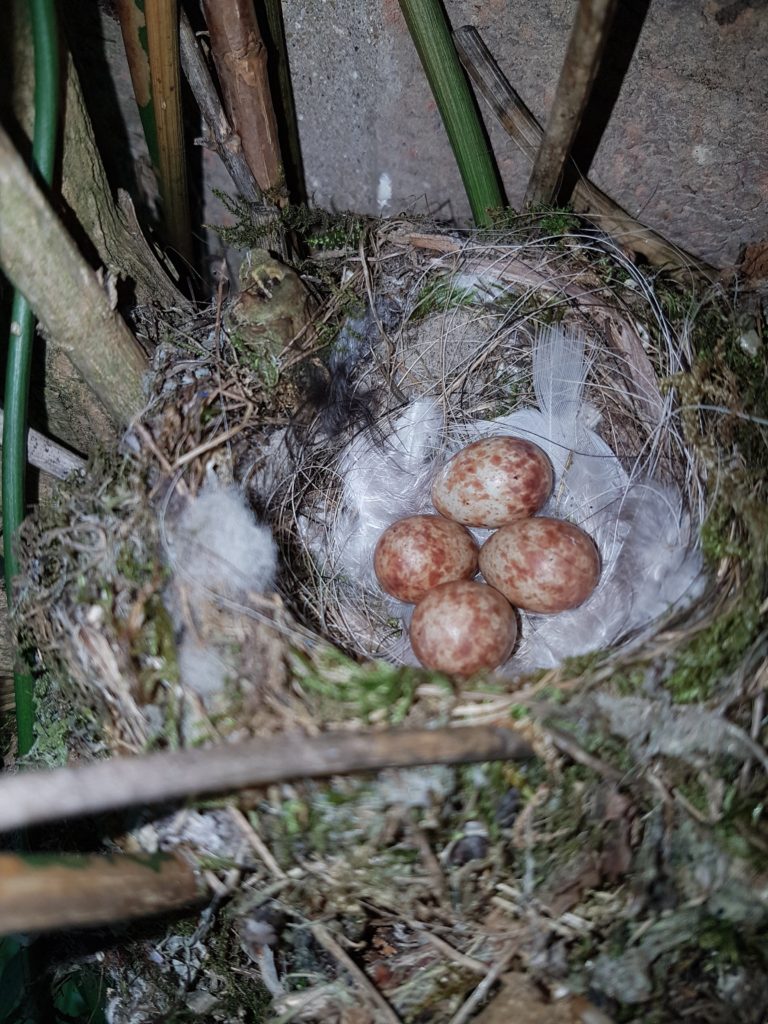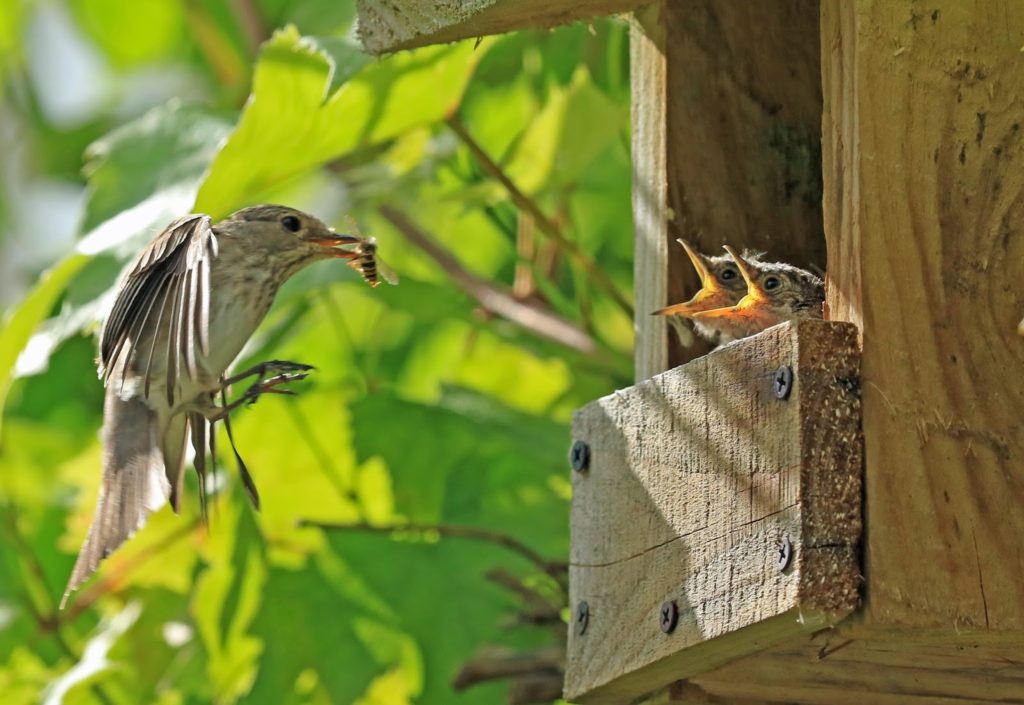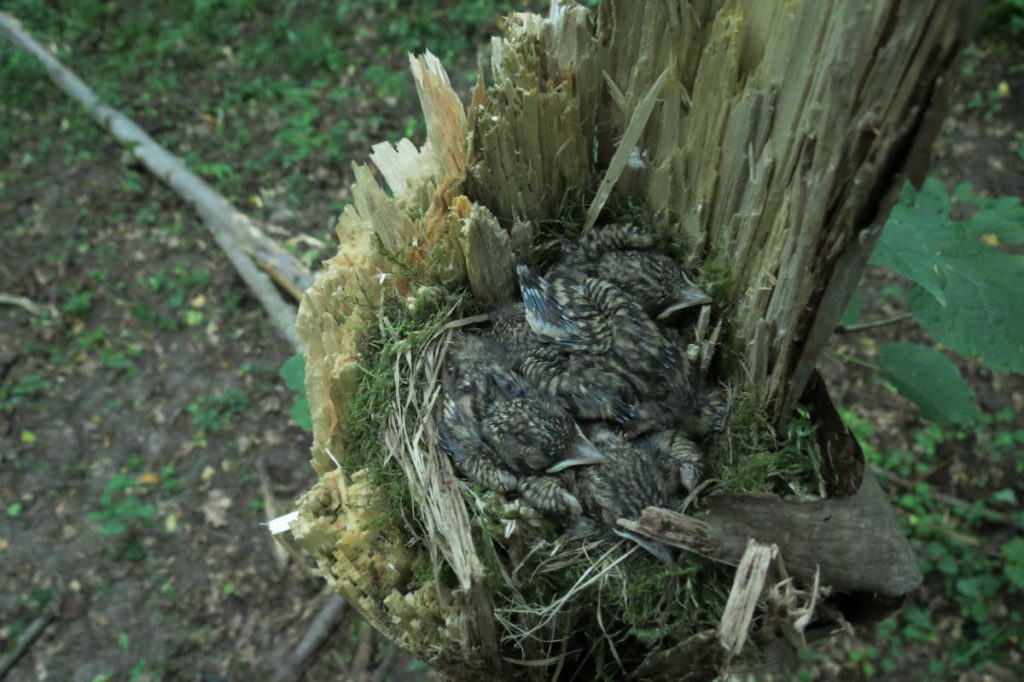studying flycatchers
Spotted Flycatchers are nowadays difficult birds to find in Cambridgeshire.
If you mention them, the first response is:
“We used to have them breeding in our garden”
and then: “But I haven’t seen one all year”

finding flycatchers (or not)
Flycatchers are extremely inconspicuous in the breeding season. They barely sing, and even when they do, the song is very missable – high-pitched and quiet; many (older) people cannot hear them at all. Males, often high in the tree canopy, cannot be relied upon to respond to song playback. The pair may not show itself when a nest is visited and may even be entirely absent while nestlings are ringed. RSPB field notes suggest that three negative visits are required in order to safely establish the absence of birds.
With the exception of one or two well-known sites, almost no records were received in any of the project years 2015-19 from birders, through BTO BirdTrack, via the Cambirds Google Group or from the Cambridgeshire Bird Club database. Ordinary birdwatchers do not record flycatchers.
Apart from the obvious reason (the catastrophic decline in breeding numbers) birds are hard to find because they have now largely withdrawn from accessible open habitats – farmland, woodland, river valleys – into more private spaces – gardens, parkland and churchyards. Once nesting has begun, birds will forage no further than 200m from the nest, and will stay much closer than that once they are feeding young. Foraging is usually silent and often high in the canopy.

The geolocator project has, of course, also concentrated on locating ‘suitable’ pairs to tag and subsequently to recapture for tag retrieval. The project requirements were for
- established pairs which would be site-faithful
- easy householder or landowner access
- catchability.
This last has tended to rule out awkward woodland sites where nests might be high, or where it would be impossible to deploy mist-nets or traps. So there was also an undeniable bias towards human habitats within the project
where flycatchers are hanging on
However, the main reason that flycatchers were only rarely found in woodland was because they are in the main no longer to be found there. Many of the county’s woodlands still provide superficially perfect traditional habitat and many are reserves in their own right (Wildlife Trust BCN, RSPB, NE, NT) or parts of larger landscapes which are wardened and extensively visited by people who would recognise flycatchers if they saw them. And yet there are almost no records from reserves.

During the project it became very easy to identify suitable places to look for breeding flycatchers. Most were in villages and in parkland. While once common in the larger cities, Cambridge, Peterborough, Ely, St Neots, birds are no longer found there. Again it seems unlikely that birds breeding in traditional city habitats (for example within Cambridge – the Backs, the Botanic Garden, Coe Fen, large south and west city gardens) are escaping detection.
Village sites were almost always insulated from wildlife-depleted and invertebrate-poor Cambridgeshire arable farmland; often by several hundred metres. There was often livestock nearby – horses, cattle or sheep. There were strong associations with garden ponds and streams; with butterfly-rich herbacious borders; and with open areas which provided good perches for flycatching. A rich choice of nest-sites was often available, either in creepers (particularly Climbing Hydrangea and Wisteria); in ivy-clad trees; or in open-fronted nestboxes. ‘Free-range’ pet dogs running around a garden from an open kitchen door also suggested an association, since they obviously discourage the main potential garden predators: Jays, Magpies, domestic cats and Grey Squirrels.

background research, fieldwork and social media
Pairs were located by a combination of deskwork and fieldwork. A first stage was to review as many previous records as possible: in Cambridgeshire Bird Reports; in the CBC database; on BirdTrack and in the 2008-11 Bird Atlas data set. As many sites as possible were then visited, but time was concentrated on areas within forty minutes or so of Cambridge. This meant that little fieldwork was carried out in the northern and eastern parts of the county. Once at a site, playback lures were used in the hope of attracting male birds, doorbells were rung, and obvious sites cold-searched.
Parkland and rural churchyards shared some characteristics. Pollarded limes provided popular nest-sites. Weedy areas, and particularly Cow Parsley certainly improved the number of flying insects.
During early 2017 an attempt was made to publicise the project through contacting parish and local magazines and community websites. By 2018 news of the project seemed to be spreading via word of mouth and a number of new householders came forward with previously unrecorded pairs.
aspects of breeding biology
If their very thin and scattered distribution in Cambridgeshire makes flycatchers difficult for us find, then it is not surprising that there is evidence that birds also find it difficult to find a partner – for example, when one of an established pair hasn’t made it back from migration and the survivor needs to find a replacement. While some pairs, returning more or less together to regular sites can get straight on with nesting and might have young fledging by the third week of June, other pairs are clearly hooking up for the first time over a month later, perhaps after a wide-ranging search for a partner. Such a search won’t really be limited by habitat; good gardens, churchyards, parkland and woodland are not in short supply. There is also evidence that arrival dates into the country can in some years be spread over a considerable period, from mid-May until well into June.
Fortunately, however, flycatchers are well-suited to an extended breeding season – they have a wide variety of seasonal insect prey to feed on. Late first broods can thus be in the nest throughout July, some even coinciding with the smaller second broods (or replacement broods) of earlier-arriving pairs. This may be a factor in helping the species to breed successfully as it becomes increasingly thin on the ground. This could not be further from Blue Tit ecology, where each pair can allow itself just one all-or-nothing attempt which will succeed or fail according to its synchronisation with caterpillar availability in the second half of May, with up to ten nestlings needing to be fed. With the exception of a few rare cases of predation and losses due to extreme weather, flycatcher nesting outcomes in Cambridgeshire were on the whole successful.

additional insights
A by-product of the geolocator project, which depends on capturing the adult birds and marking them individually, were some additional insights into breeding behaviour. There was little new to be learnt here, as the species has been very extensively studied both in Britain and in Europe, but some aspects were nonetheless interesting.
There was a definite tendency for pairs to be clustered into hotspots, almost communities, where numbers allowed. In one year six pairs nested within one square kilometre and, within that, four were within 100 metres of each other and two nests were on the same side of the same building. One might speculate here about family relationships and returning offspring.
Polygamy has been regularly recorded in the species. We had several cases of a single male with two females; and even more cases of ‘inattentive’ males who were almost entirely absent during the nest-provisioning stage, leaving all the hard work to a single mother. There was one case of a nest with two males in attendance.
